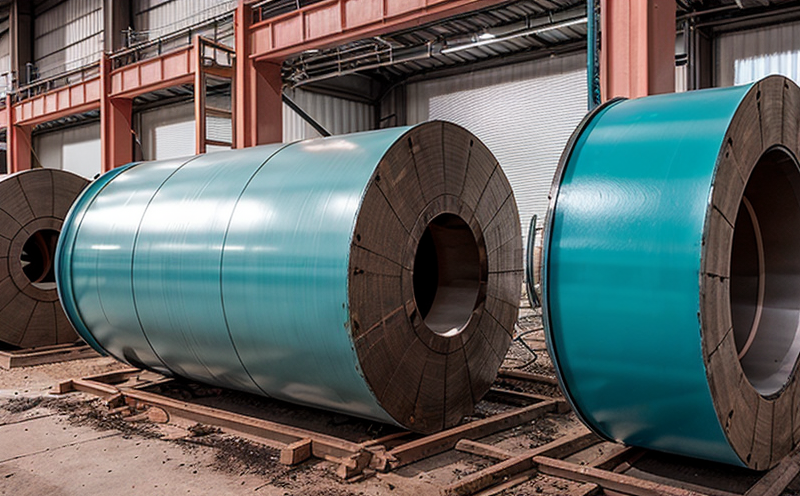ISO 21062 Galvanic Corrosion Testing of Metals
The ISO 21062 standard specifies a galvanic corrosion testing method for metals used in industrial manufacturing and processing applications. This test is crucial for evaluating the resistance of metal components to galvanic corrosion, which occurs when two different metals come into direct electrical contact with an electrolyte solution.
Galvanic corrosion is a significant issue in various sectors where multiple metallic parts are present, such as automotive, aerospace, and marine industries. It can lead to premature failure of equipment and costly downtime if not properly addressed during design and manufacturing stages. The ISO 21062 test provides a standardized approach for assessing the durability of metal components under controlled conditions.
The testing procedure involves placing two different metals in a solution that simulates real-world environments, such as seawater or industrial chemicals. Voltage measurements are taken over time to determine the rate and extent of corrosion. This method allows engineers and quality managers to make informed decisions about material selection and component design.
One key aspect of ISO 21062 testing is its focus on real-world scenarios. By simulating actual operating conditions, this test helps identify potential issues early in the development process, reducing the risk of field failures. The standard also emphasizes the importance of accurate data collection and interpretation, ensuring consistent results across different laboratories.
Another important feature of ISO 21062 is its adaptability to various metal types and applications. Whether you're working with stainless steel, aluminum, or brass components, this test can provide valuable insights into galvanic corrosion behavior. This flexibility makes it an essential tool for R&D teams looking to innovate and improve product performance.
For procurement professionals, ISO 21062 testing offers a way to ensure suppliers meet stringent quality standards. By requiring suppliers to undergo this test, companies can maintain consistent material quality across their supply chain. This not only enhances product reliability but also fosters trust within the industry.
In conclusion, ISO 21062 galvanic corrosion testing is an indispensable tool for industrial manufacturing and processing sectors. It provides a robust framework for evaluating metal resistance to corrosion, ensuring long-lasting performance in challenging environments. By leveraging this standard, organizations can enhance product durability, improve customer satisfaction, and achieve regulatory compliance.
Industry Applications
| Application Sector | Description of Application |
|---|---|
| Aerospace | The aerospace industry relies heavily on metal components that must withstand harsh environmental conditions. ISO 21062 testing is used to evaluate the durability of metals in aircraft structures and engine parts. |
| Automotive | In automotive manufacturing, galvanic corrosion can affect vehicle performance and safety. This test helps ensure that metal components like exhaust systems and fuel lines are resistant to corrosion. |
| Marine | The marine industry deals with environments rich in saltwater, which can accelerate galvanic corrosion. ISO 21062 testing is critical for assessing the durability of metals used in ship construction and maintenance. |
| Oil & Gas | In oil and gas exploration and production, metal components are exposed to a wide range of corrosive substances. This test ensures that equipment like pipelines and drilling tools can withstand these conditions without failure. |
Why Choose This Test
- Provides standardized testing parameters for evaluating galvanic corrosion resistance.
- Helps identify potential issues early in the product development process, reducing field failures.
- Ensures consistent results across different laboratories, enhancing reliability and accuracy.
- Facilitates informed decision-making regarding material selection and component design.
- Supports compliance with international standards and regulatory requirements.
- Enhances product durability and performance in challenging environments.
- Fosters trust within the industry by ensuring suppliers meet stringent quality standards.
Competitive Advantage and Market Impact
Adopting ISO 21062 galvanic corrosion testing offers several competitive advantages for industrial manufacturing companies:
- Innovation Leadership: By staying ahead of industry trends, organizations can introduce more durable products to market.
- Better Customer Satisfaction: Products with superior corrosion resistance are less likely to fail prematurely, leading to higher customer satisfaction and loyalty.
- Cost Savings: Early identification of potential issues through testing reduces the risk of costly repairs or replacements in the field.
- Regulatory Compliance: By adhering to international standards, companies can ensure they meet regulatory requirements and avoid penalties.
- Better Supplier Relationships: Requiring suppliers to undergo this test builds trust and ensures a consistent supply of high-quality materials.
In the competitive landscape of industrial manufacturing, these advantages are crucial for maintaining a strong market position. ISO 21062 testing not only enhances product performance but also strengthens overall business resilience.





